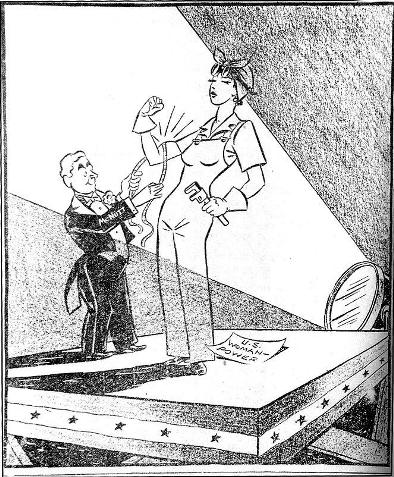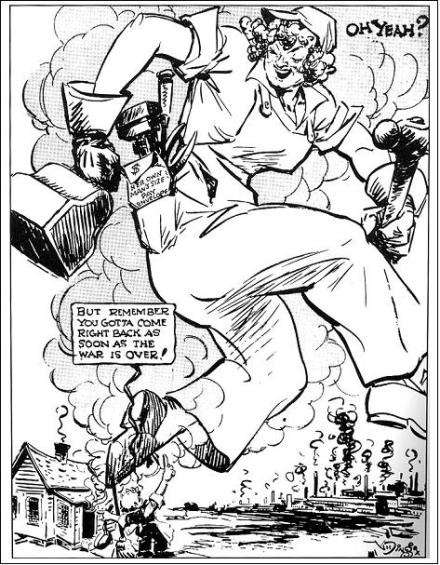LESSON PLAN:
The Working Women of WWII: Analyzing Editorial Cartoons
American women played a vital role in the Allies victory in WWII. More than 400,000 served in the military and millions worked in defense industries on the Home Front. WWII gave women new opportunities for work and independence. Some people viewed these changes as positive, some as negative. Many people were ambivalent about the social changes that effected women during the war. This ambivalence can be explored in contemporary images of women from that era.
Objective:
Students will learn about the social tensions brought about by women entering the workforce during WWII by analyzing portrayals of women in editorial cartoons.
Grade Level: 7-12
Standards:
History Thinking Standard 4—the student interrogates historical data by uncovering the social, political, and economic context in which it was created. Historical Thinking Standard 5—the student identifies issues and problems in the past and analyzes the interests, values, perspectives, and points of view of those involved in the situation.
Content Era 8 (1929-1945) Standard 3C—the student understands the effects of World War II at home.
Time Requirement: One to two class periods
Download a printable pdf version of this lesson plan
Directions:
1. Present a brief lesson on women’s experiences of WWII. Focus on the fact that large numbers of women went to work to increase war production. Included in the lesson is a Fact Sheet on American Women in WWII that is helpful. Ask students what social conflicts this may have caused.
2. Pass out copies of the “Anything You Can Do” list and give students two minutes to complete the activity. Review their answers. Inform students that women held every one of the jobs on the list during WWII.
3. Pass out copies of the two editorial cartoons. Students may either answer the questions individually or as pairs on a separate sheet of paper, or you may hold a group discussion using the questions. Remind students to pay close attention to details when analyzing editorial cartoons.
4. If students answer questions on own their own, end the class with a group discussion. Discuss each question as a group.
Assessment:
Components for assessment include the written questions and the class discussion.
Enrichment:
Have students find editorial cartoons in the newspaper and answer the following questions about them: what is the subject matter of the cartoon? How does the artist feel about the subject? Do you agree with the artist—why or why not?
Anything You Can Do...: WWII Jobs for Women
During WWII women found jobs that had previously been performed only by men.
aerodynamic engineer |
aircraft spotter |
architect |
astronomer |
barber |
baseball player |
bus driver |
butcher |
cargo loader |
chemist |
crane operator |
draftsman |
drawbridge tender |
electrician |
fire fighter |
flash welder |
forest fire fighter |
foundry helper |
furnace operator |
garbage collector |
geologist |
journalist |
keel welder |
lumberjack |
maintenance worker |
mathematician |
mechanic |
messenger |
meteorologist |
milkman |
oiler |
ordinance worker |
packer and shipper |
physicist |
pilot |
pipe fitter |
postal carrier |
radio engineer |
railroad track tender |
riveter |
scientist |
shell assembler |
shipfitter |
steam hammer operator |
street cleaner |
surveyor |
sweetbread puller |
taxi driver |
telegraph operator |
ticket taker |
tinsmith |
tool machinist |
traffic cop |
train porter |
The Editorial Cartoon
Editorial cartoons that appear in newspapers and magazines are meant as entertainment, but they also reflect a political or moral stance, or present a critique on a current event or on society as a whole. Study this 1943 cartoon from the Daily Hampshire Gazette and answer the questions below.

This cartoon shows War Manpower Commissioner Paul McNutt judging a woman in a pageant, not for her beauty, but for her strength.
1. What was the artist’s purpose in drawing this cartoon?
2. What characteristics describe the woman?
3. Who was the artist’s audience (for whom was this cartoon meant?)
4. Does the artist make the reader feel patriotic, optimistic, and strong? How?
5. How does this cartoon make you feel? Why?
Now compare the first cartoon to this one from the Des Moines Register, also printed in 1943. Answer the questions below.

1. What do you think the creator of this cartoon was trying to say?
2. Which characteristics describe the woman? Which describe the man?
3. Is the man in favor of or against women working outside the home?
4. Do you think others shared his opinion? Who?
5. How does this cartoon make you feel? Why?
6. Which cartoon do you like better and why?
Download a printable pdf version of this lesson plan
TAKE ACTION:


EDUCATION PROJECTS:
Student Travel – WWII Educational Tours
High school and college students, learn the leadership principles that helped win WWII on a trip to France or during a weeklong residential program in New Orleans. College credit is available, and space is limited.
See You Next Year! HS Yearbooks from WWII
Collected from across the United States, the words and pictures of these yearbooks present a new opportunity to experience the many challenges, setbacks and triumphs of the war through the eyes of America’s youth.
The Victory Gardens of WWII
Visit the Classroom Victory Garden Project website to learn about food production during WWII, find lesson plans and activities for elementary students, get tips for starting your own garden and try out simple Victory Garden recipes!
The Science and Technology of WWII
Visit our new interactive website to learn about wartime technical and scientific advances that forever changed our world. Incorporates STEM principles to use in the classroom.
Kids Corner: Fun and Games!
Make your own propaganda posters, test your memory, solve puzzles and more! Learn about World War II and have fun at the same time.



